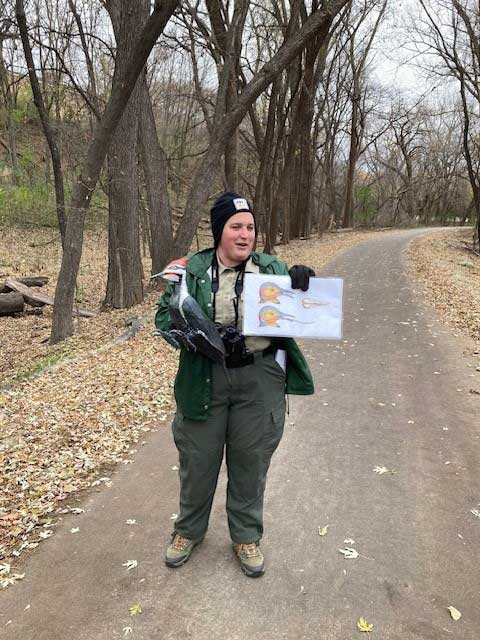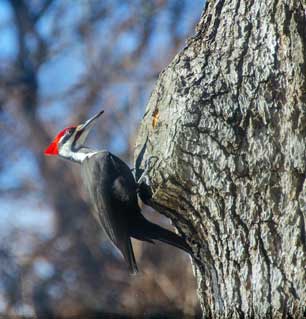Adventures At Fort Snelling State Park – What You Don’t See You Will Hear: The Search For Wily Woodpeckers
By Deborah Locke, DNR Information Officer
Maybe like me, your first introduction to woodpeckers took place in the 1960s on a 30-minute television cartoon show, “Woody Woodpecker.” The whacky, red-headed character created for movie theaters in 1940 had this loud, ha-ha-ha-ha-ha cackle.
My second introduction to woodpeckers, occurring long past the days of cartoon watching, took place at Fort Snelling State Park on a brisk November day when a knowledgeable naturalist helped us watch the birds for real. The “Wily Woodpeckers” bird watching program led by naturalist Amy Mester took us on a path into the park in search of Minnesota’s woodpecker species. We used borrowed binoculars, following Amy as she informed the group of 11 about the nine species of woodpeckers in Minnesota. Seven of the nine species either live in or have been spotted at Fort Snelling State Park.
Nine species of woodpeckers. Here? For the cartoon-only educated, that was eight more than I expected. Like human Minnesotans, woodpeckers are a hardy lot that overwinter. Their tree pecking at both standing and fallen trees creates a distinct noise. As we walked, looked, and listened, it became clear that fall is a good season for bird watching since most foliage is down. Plus, there’s an air of quiet expectation, as the land, vegetation and wildlife prepare for winter. Two deer were spotted on our short hike, and squirrels raced around, frantically storing food for winter.
Amy, who was very tuned to forest sound, both saw and heard the woodpeckers first, flying between trees. We saw three woodpecker species that live at the park: the downy, hairy, and red-bellied woodpecker. Less common are the pileated (the bird Woody is based on) and red-headed woodpecker, the northern flicker, and the yellow-bellied sapsucker. The most persistent Minnesota bird watchers may see the black-backed and American three-toed woodpecker, spotted only in the dead of winter in the state’s northern boreal habitats.
Amy pointed out the small downy woodpecker, which from the ground appeared to be five to seven inches long. The birds flitted from tree to tree, stopping to peck, then moving on. Several sharp-eyed members of our group spotted the birds immediately and zoomed in with binoculars. Others (me) searched in vain without any luck. I didn’t get a close-up view but did see the darting birds in flight. That was a small victory. Not present was any bird resembling Woody Woodpecker, the troublemaker from my cartoon-watching youth.
Our naturalist guide carried a model of the pileated woodpecker, which she made herself. The species can grow up to 19 inches in length — the same length as the model so we could see how large the birds get. Their padded brains protect their heads from injury from pecking and drumming, and their abnormally long tongues help with insect removal. Their eyes are protected with special folds to absorb the pecking motion, and their flexible claws easily grip tree bark.
The hour-long program offered fresh air, conversations with fellow park visitors, information on wildlife, and a way to get away from my keyboard. See information below on finding your nearest state park or trail and finding a program of interest.
Photos courtesy Minnesota DNR.
Most state park programs are free, but some require pre-registration. Also, you will need a day permit ($7) to enter a park; permits can be bought online or at the park during visitor hours. Call ahead to see if the visitor center will be open. To find a nearby state park, go to mndnr.gov/parkfinder. To see calendar events, see mndnr.gov/ptcalendar. Always check the park website for visitor alerts before you leave, dress for the weather, and know that the visitor centers are often located a couple miles into the park so plan your arrival accordingly.

























